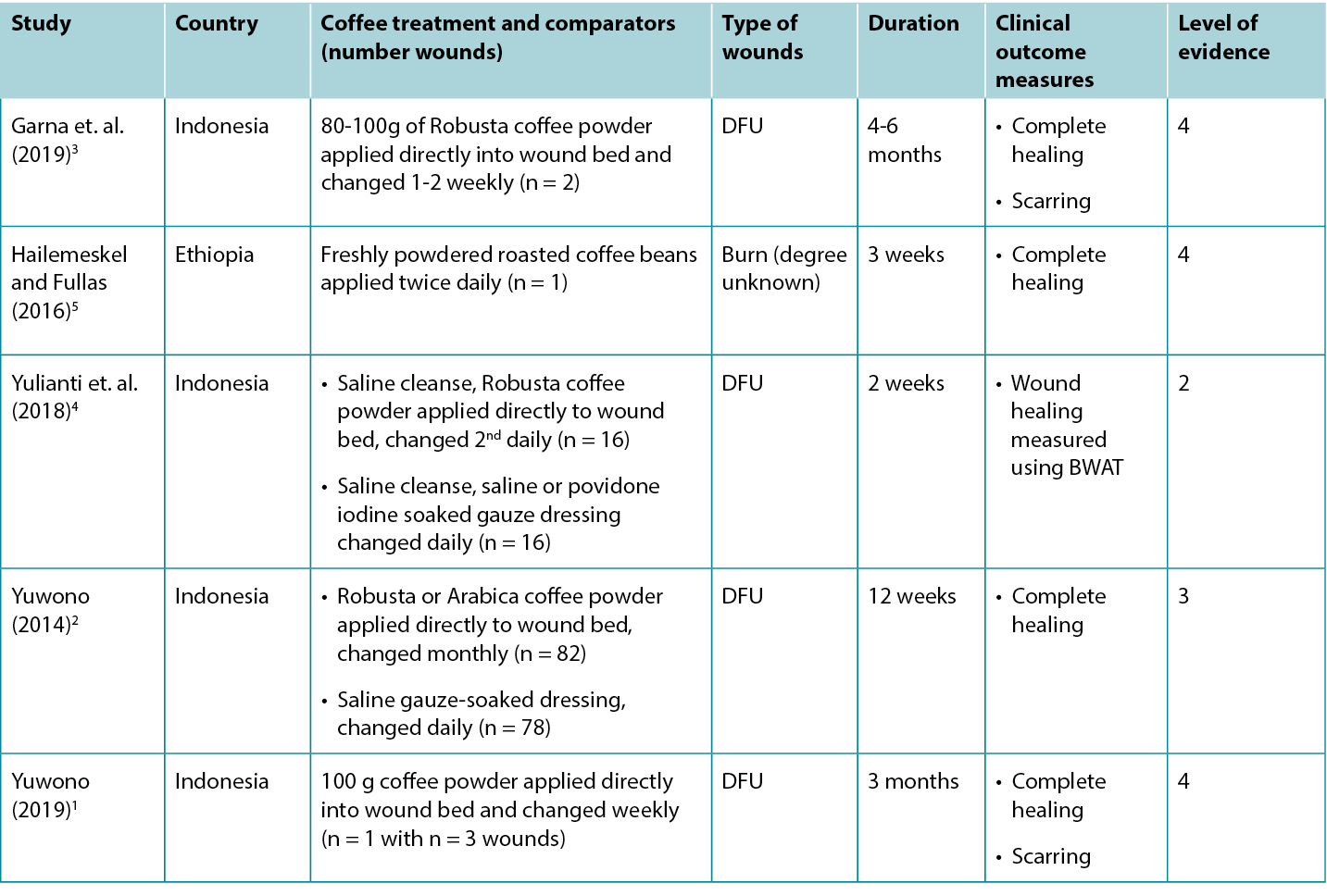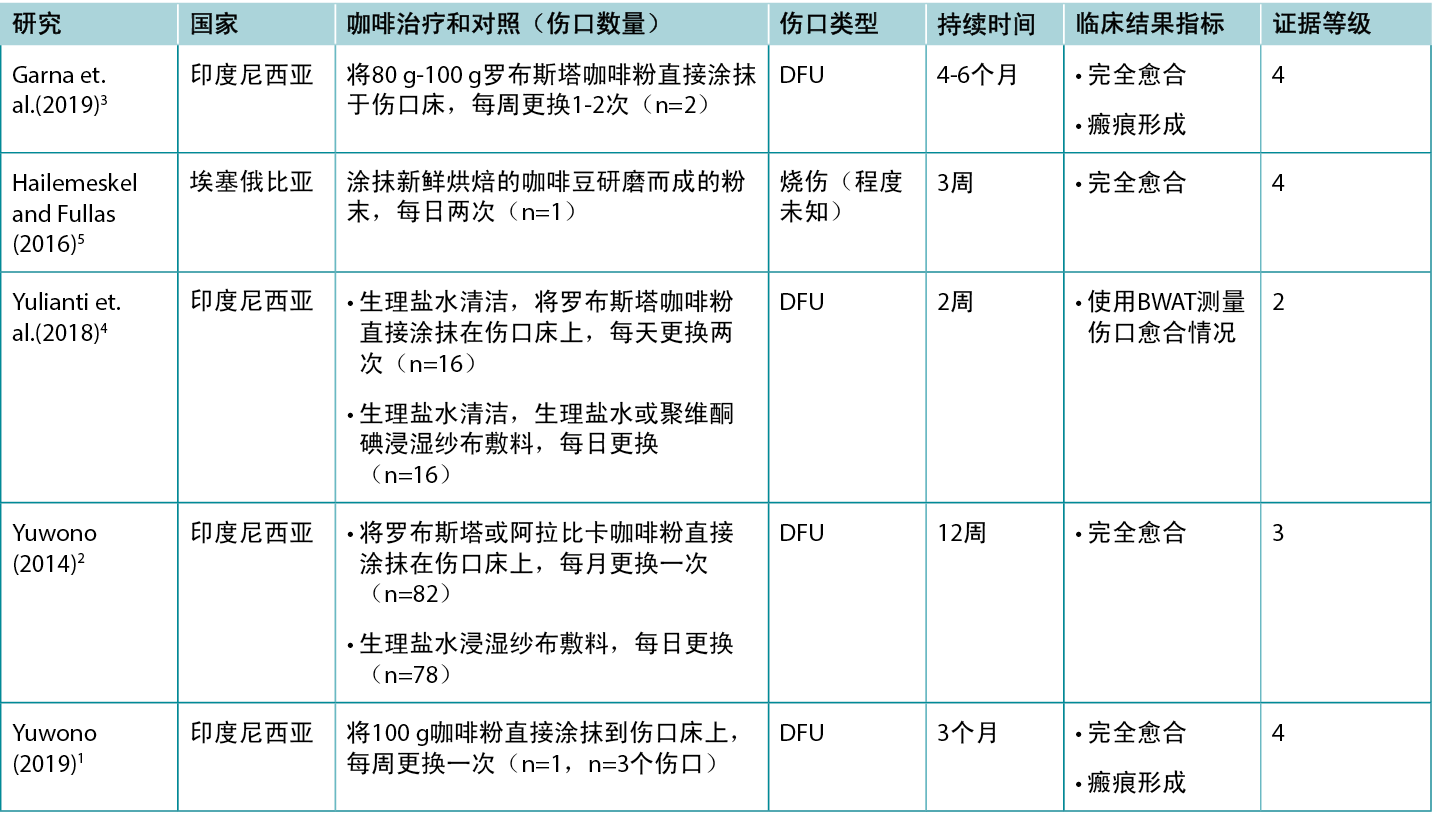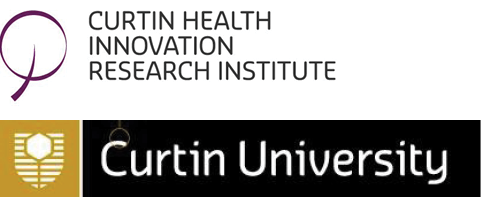Volume 43 Number 3
WHAM evidence summary: coffee powder for wound healing
Emily Haesler
Keywords Traditional wound management, coffee, coffee powder dressing, evidence summary.
For referencing Haesler E. WHAM evidence summary: coffee powder for wound healing. WCET® Journal 2023;43(3):36-39
DOI https://doi.org/10.33235/wcet.43.3 .36-39
Clinical question
What is the best available evidence for topical coffee powder for improving wound healing?
Summary
Coffee powder is used as a traditional wound healing option in low and middle resource communities, particularly in Indonesia1, 2. It is claimed to have antimicrobial, anti-inflammatory and antioxidant effects that promote growth of new tissue1-4. Additional possible benefits include absorption of wound exudate and concealing wound malodor. However, the evidence for the use of coffee powder for healing human wounds is very limited. Level 24 and Level 32 evidence reported complete wound healing within 12 weeks for diabetic foot ulcers (DFUs) treated with coffee powder without adverse effects. This was supported by Level 4 evidence1, 3, 5. However, all the studies were at high risk of bias, and there is a need for further research on the effectiveness and implications for using coffee powder before a recommendation could be made on this intervention for treating wounds.
Clinical practice recommendations
All recommendations should be applied with consideration to the wound, the person, the health professional and the clinical context.
| There is insufficient evidence to make a recommendation on the use of topical coffee powder to promote wound healing. |
Sources of evidence: search and appraisal
This summary was conducted using methods published by the Joanna Briggs Institute6-8. The summary is based on a systematic literature search combining search terms related to topical coffee treatments and wound healing. Searches were conducted for evidence reporting use of topical coffee in human wounds published up to 30 June 2023 in English in the following databases: Cumulative Index to Nursing and Allied Health Literature (CINAHL), Medline (Ovid), Google Scholar, Embase (Ovid), AMED, Global Health, Health Internetwork Access to Research Initiative (Hinari, access via Research4Life) and Cochrane Library. Levels of evidence for intervention studies are reported in Table 1.
Table 1: Levels of evidence for clinical studies

Background
Coffee powder is described as a traditional option for treating wounds, particularly in Indonesia. Coffee powder is reported to have antioxidant, antimicrobial and anti-inflammatory effects3, 4. Bench research suggests that these properties might derive from coffee’s chemical composition, including 5-hydroxymethylfurfural (5-HMF)9, polyphenols (e.g., caffeic acid and chlorogenic acid)10, 11 and growth factors12. Some bench research has reported accelerated wound healing in animal wounds treated with coffee powder13-16. Additional bench research has explored impregnation of coffee into wound dressing materials, but the literature search did not identify any clinical trials of these products10, 11 in humans.
When coffee powder is placed in a wound bed it mixes with wound exudate resulting in a hyperosmolar solution with a low minimum inhibitory concentration against Methicillin-resistant Staphylococcus aureus1-3, 5, Streptococcus spp. and gram-negative bacteria5. Coffee powder may absorb wound exudate4, 5 and its aromatic characteristics might conceal wound malodor1-4. Another possible benefit of coffee powder described in the literature is protection of the wound bed1-3. When applied directly to the wound, coffee powder adheres to the wound bed surface. When changing the coffee powder dressing, the wound is not cleansed and the coffee layer in contact with the wound bed is left untouched. This allows epithelial tissue to develop without disruption1, 3.
Clinical evidence on coffee powder for wound healing
Studies reporting clinical outcomes for treatment with coffee are summarised in Table 2.
Table 2: Summary of the evidence for coffee powder for wound healing

Coffee powder for promoting wound healing
The strongest evidence for coffee powder comes from a quasi-experiment at high risk of bias that was conducted in people with DFUs4. The intervention group (n = 16) were treated with saline wound cleansing and application of Robusta coffee powder into the wound bed every second day. The control group (n = 16) received daily saline cleansing and were packed with saline- or povidone iodine-soaked gauze. Almost all (n = 30/32) participants also received systemic antibiotics. Wounds were assessed using the Bates-Jensen Wound Assessment Tool (BWAT) administered prior to commencing treatment and after two weeks. Both groups achieved statistically significant improvements (p < 0.001) in BWAT scores over two weeks of treatment, but the improvement was statistically significantly (p = 0.005) greater in the coffee powder group. Many of the participants were recruited to the study after their DFU had been surgically debrided (44% in the treatment group and 25% in the control group), which might have influenced the findings4 (Level 2).
A comparative study2 at high risk of bias reported coffee powder held in situ with gauze (n = 82) compared with saline-soaked gauze dressing (n = 78) in DFUs with a baseline wound diameter of 3—5 cm. The wound dressing was changed every four weeks for the coffee powder group and daily for the saline group. At 12 weeks, 100% of the wounds treated with coffee powder were completely healed versus 72% in the saline group (p < 0.001)2 (Level 3).
The remaining evidence comes from case reports from Indonesia and Ethiopia. Two case reports3 at high risk of bias reported use of coffee powder for healing deep DFUs of the heel. For the first DFU, dry coffee powder was applied directly to the wound bed, secured in place with gauze and tape and changed every 1—2 weeks. The ulcer healed completely within six months. The second case was described as a “festering” DFU that was treated with coffee powder applied directly into the wound bed and changed every 7—14 days. Complete healing was achieved within four months. For both cases, the report indicated that using coffee powder was protective of the epithelializing wound bed and also facilitated the person’s mobility and independence3 (Level 4).
Another case report at high risk of bias1 described the treatment of DFUs with coffee powder. Following debridement of an abscess, the person had three DFUs on one foot. These were packed with 100 g of coffee powder and secured with a gauze bandage. As with the cases reported above, when changing the dressing the wound was not cleansed, the coffee powder directly in contact with the wound bed was left undisturbed and any loose, superficial coffee powder was replaced. The wounds healed completely within three months1 (Level 4).
The next case report5, also at high risk of bias, described the use of freshly roasted Robusta coffee to treat a paediatric patient with a thigh burn. Coffee powder applied directly to the child’s burn was initiated on day four by the child’s parent. The dressing was changed twice daily and maintained dry. After three weeks of home treatment with the coffee powder, the burn was completely healed5 (Level 4).
Considerations for use
- Consider local policies, procedures, and licensing before implementing traditional wound treatments.
- Robusta coffee is reported to have greater antioxidant properties than Arabica coffee and is reported to be the preferred coffee species for traditional wound treatment4.
- In the research above, the coffee powder was ground from Robusta or Arabica beans (i.e., not instant coffee powder), purchased locally from coffee shops3. The process for grinding and the fineness of the powder were not reported, nor was any sterilization.
In the case studies above, coffee powder was used in a volume of approximately 80—100 g (enough to fill the wound bed). The coffee powder was secured in place with dry gauze and tape. When changing the coffee powder dressing, cleansing was avoided, any loose coffee was removed, leaving the layer of coffee in contact with the wound bed undisturbed. Fresh coffee powder was added3. In contrast, the treatment regimen in the quasi-experiment included saline cleansing when changing the coffee powder dressing, which necessitated more frequent dressing changes4.
Adverse effects
No adverse events were reported in any of the research included in this evidence summary and no potential adverse effects were discussed in the literature.
Conflicts of interest
The author declares no conflicts of interest in accordance with International Committee of Medical Journal Editors (ICMJE) standards.
About WHAM evidence summaries
WHAM evidence summaries are consistent with methodology published in Munn Z, Lockwood C, Moola S. The development and use of evidence summaries for point of care information systems: A streamlined rapid review approach, Worldviews Evid Based Nurs. 2015;12(3):131-8. Methods are outlined in resources published by the Joanna Briggs Institute6-8 and on the WHAM Collaborative website: http://WHAMwounds.com. The WHAM evidence summaries undergo peer-review by a 20-member international, multidisciplinary Expert Reference Group (available on the website). WHAM evidence summaries provide a summary of the best available evidence on specific topics and make suggestions that can be used to inform clinical practice. Evidence contained within this summary should be evaluated by appropriately trained professionals with expertise in wound prevention and management, and the evidence should be considered in the context of the individual, the professional, the clinical setting and other relevant clinical information.
Copyright © 2023 Wound Healing and Management Collaboration, Curtin University
WHAM证据总结:咖啡粉用于伤口愈合
Emily Haesler
DOI: https://doi.org/10.33235/wcet.43.3 .36-39
临床问题
外用咖啡粉改善伤口愈合情况的最佳可用证据是什么?
概述
在资源匮乏和资源中等的社区,特别是在印度尼西亚,咖啡粉是一种传统的伤口愈合方法1, 2。据称,其具有抗菌、抗炎和抗氧化作用,可促进新组织的生长1-4。其可能带来的其他获益包括吸收伤口渗出液和掩盖伤口恶臭。然而,咖啡粉用于愈合人体伤口的证据非常有限。2级4和3级2证据报告称,接受咖啡粉治疗的糖尿病足溃疡(DFU)在12周内实现伤口完全愈合,且无不良反应。上述情况得到了4级证据1, 3, 5的支持。不过,所有研究均存在较高的偏倚风险,需对使用咖啡粉的效果和影响进行进一步研究,然后才能就这种用于治疗伤口的干预措施提出建议。
临床实践建议
采用任何建议时,应考虑伤口、患者、专业医护人员和临床环境。
| 尚无足够的证据支持使用外用咖啡粉来促进伤口愈合的建议。 |
证据来源检索和评价
本总结采用乔安娜·布里格斯研究所公布的方法
进行6-8。本总结基于系统性文献检索,结合了与外用咖啡治疗和伤口愈合相关的检索词。在以下数据库中检索了截至2023年6月30日以英文报告的关于在人体伤口中使用外用咖啡的证据:护理与联合卫生文献累积索引(CINAHL)、Medline(Ovid)、谷歌学术、Embase(Ovid)、AMED和卫生互联网共享研究成果倡议(Hinari,通过Research4Life访问)和Cochrane图书馆。表1报告了干预研究的证据等级。
表1:临床研究的证据水平

背景
据介绍,咖啡粉是一种传统的伤口治疗方法,特别是在印度尼西亚。有报告称,咖啡粉具有抗氧化、抗菌和抗炎作用3, 4。实验室研究表明,这些特性可能源于咖啡的化学成分,包括5-羟甲基糠醛(5-HMF)9、多酚(例如,咖啡酸和绿原酸)10, 11和生长因子12。一些实验室研究报告了接受咖啡粉治疗动物的伤口愈合速度加快13-16。其他实验室研究对咖啡浸渍伤口敷料材料进行了探索,但文献检索并未发现这些产品在人体中进行过任何临床试验10, 11。
将咖啡粉应用于伤口床时,其与伤口渗出液混合,产生高渗溶液,对耐甲氧西林金黄色葡萄球菌1-3, 5、链球菌属和革兰氏阴性菌5的最低抑菌浓度较低。咖啡粉可吸收伤口渗出液4, 5,其香气特征可掩盖伤口恶臭1-4。文献中所述的咖啡粉可能带来的另一个获益是保护伤口床1-3。直接涂抹在伤口上时,咖啡粉会附着在伤口床表面。更换咖啡粉敷料时,无需清洁伤口,与伤口床接触的咖啡层保持原样。这使得上皮组织的发育不受干扰1, 3。
咖啡粉用于伤口愈合的临床证据
表2总结了报告咖啡治疗的临床结局的研究。
表2:咖啡粉用于伤口愈合的证据总结

咖啡粉用于促进伤口愈合
证明咖啡粉效果的最有力证据来自在DFU4人群中进行的偏倚风险较高的准实验。干预组(n=16)接受生理盐水伤口清洁,伤口床内涂抹罗布斯塔咖啡粉,每两天一次。对照组(n=16)接受每日生理盐水清洁,并使用生理盐水或聚维酮碘浸湿的纱布进行填充。几乎所有(n=30/32)受试者均接受了全身性抗生素治疗。在开始给药前以及两周后,使用Bates-Jensen伤口评估工具(BWAT)对伤口进行评估。在两周的治疗过程中,两组均的BWAT评分均出现了具有统计学显著性的改善(p<0.001),但咖啡粉组中改善的统计学显著性(p=0.005)更高。部分参与者在进行了DFU手术清创后被招募进入研究(治疗组有44%,对照组有25%),这可能会对结果产生影响4(2级)。
一项偏倚风险较高的比较研究2报告了在基线伤口直径为3 cm-5 cm的DFU中,使用纱布将咖啡粉保持在原位(n=82)与生理盐水浸湿的纱布
敷料(n=78)的比较结果。咖啡粉组每四周更换一次伤口敷料,生理盐水组每天更换一次。在12周时,咖啡粉组的伤口完全愈合率为100%,而生理盐水组为72%(p<0.001)2(3级)。
其余证据均来自印度尼西亚和埃塞俄比亚的病例报告。在两份偏倚风险较高的病例报告3中,报告了咖啡粉用于治疗足跟深部DFU的情况。首次出现DFU时,将干燥的咖啡粉直接涂抹在伤口上,用纱布和胶带固定,每1-2周更换一次。溃疡在六个月内完全愈合。第二例病例描述为“溃烂”的DFU,治疗方法为将咖啡粉直接涂抹在伤口床上,每7-14天更换一次。在四个月内实现完全愈合。报告指出,在这两个病例中,使用咖啡粉对上皮化伤口床具有保护作用,且可提高患者的活动性和独立性3(4级)。
另一份偏倚风险较高的病例报告1描述了咖啡粉用于治疗DFU的情况。进行脓肿清创术后,患者一只脚出现三处DFU。用100 g咖啡粉填充,并用纱布绷带固定。与上文报告的病例相同,在更换敷料时,未清洁伤口,直接接触伤口床的咖啡粉保持原样,替换任何松散的表面咖啡粉。伤口在三个月内完全愈合1(4级)。
下一份病例报告5也存在较高的偏倚风险,描述了新鲜烘焙的罗布斯塔咖啡用于治疗大腿烧伤儿童患者的情况。由儿童的父母在第4天开始将咖啡粉直接涂抹在儿童烧伤处。敷料每天更换两次,并保持干燥。接受咖啡粉家庭治疗三周后,烧伤完全愈合5(4级)。
使用注意事项
- 进行传统伤口治疗前,考虑当地政策、程序和许可情况。
- 据报告,罗布斯塔咖啡比阿拉比卡咖啡具有更强的抗氧化特性,是传统伤口治疗的首选咖啡
- 种类4。
- 在上述研究中,咖啡粉由罗布斯塔或阿拉比卡咖啡豆研磨而成(即,非速溶咖啡粉),咖啡豆均从当地咖啡店购买3。未报告研磨过程和粉末细度,也未报告任何灭菌过程。
在上述病例研究中,咖啡粉用量约为80 g-100 g(足以填充伤口床)。用干纱布和胶带将咖啡粉固定在适当位置。更换咖啡粉敷料时,无需清洁,去除任何松散的咖啡,与伤口床接触的咖啡层保持原样。加入新鲜咖啡粉3。相比之下,准实验中的治疗方案包括更换咖啡粉敷料时使用生理盐水进行清洁,这需要更频繁地更换敷料4。
不良反应
本证据总结中纳入的任何研究均未报告不良事件,文献中也未讨论潜在不良反应。
利益冲突
根据国际医学期刊编辑委员会(ICMJE)的标准,作者声明无利益冲突。
关于WHAM证据总结
WHAM证据总结采用的方法与以下文献中发表的方法一致:Munn Z, Lockwood C, Moola S. The development and use of evidence summaries for point of care information systems: A streamlined rapid review approach, Worldviews Evid Based Nurs. 2015;12(3):131-8。乔安娜·布里格斯研究所6-8和WHAM合作网站(http://WHAMwounds.com)发布的资源列出了这些方法。WHAM证据总结由20名成员组成的国际多学科专家参考小组进行同行评审(可在网站上查阅)。WHAM证据总结提供了关于特定主题的最佳可用证据的总结,并提出了可用于指导临床实践的建议。本总结中包含的证据应由经过适当培训的具有伤口预防和管理专业知识的专业人士进行评价,并应根据个人、专业人士、临床环境以及其他相关临床信息考虑证据。
版权所有˝ 2023科廷大学伤口愈合和管理协作组织。
Author(s)
Emily Haesler
PhD P Grad Dip Adv Nurs (Gerontics) BN FWA
Adjunct Professor, Curtin University, Curtin Health Innovation Research Institute, Wound Healing and Management (WHAM) Collaborative
References
- Yuwono H. A case of diabetic wound: The coffee powder protects the growth of cells on the wound bed. Am J Med Case Rep, 2019;7(5):94-9.
- Yuwono HS. The new paradigm of wound management using coffee powder. Glob J Surg, 2014;2(2):25-9.
- Garna H, Yuwono HS, Tejasari M. Vulnerable wound-base cells protected by coffee powder to better healing. Am J Med Case Rep, 2019;7(9):214-6.
- Yulianti Y, Ibrahim K, Kurniawan T. Effect of wound care using Robusta coffee powders on diabetic ulcer healing in Sekarwangi Hospital Sukabum. Padjadjaran Nursing Journal, 2018;6(1):68-76.
- Hailemeskel B, Fullas F. The use of freshly roasted coffee bean powder in the treatment of burn wound: A case report. Dermatol Open J, 2016;1(2):42-6.
- Aromataris E, Munn Z. (editors). (2017). Joanna Briggs Institute Reviewer’s Manual. The Joanna Briggs Institute: https://reviewersmanual.joannabriggs.org/.
- Joanna Briggs Institute. (2013). Levels of Evidence and Grades of Recommendation Working Party. New JBI Grades of Recommendation. Joanna Briggs Institute:Adelaide.
- Joanna Briggs Institute. (2014). Levels of Evidence and Grades of Recommendation Working Party. Supporting Document for the Joanna Briggs Institute Levels of Evidence and Grades of Recommendation. The Joanna Briggs Institute: www.joannabriggs.org.
- Kong F, Fan C, Yang Y, Lee BH, Wei K. 5-hydroxymethylfurfural-embedded poly (vinyl alcohol)/sodium alginate hybrid hydrogels accelerate wound healing. Int J Biol Macromol, 2019;138:933-49.
- Doostan M, Maleki H, Faridi Majidi R, Bagheri F, Ghanbari H. Co-electrospun poly(vinyl alcohol)/poly(e-caprolactone) nanofiber scaffolds containing coffee and Calendula officinalis extracts for wound healing applications. J Bioact Compat Polym, 2022;37(6):437-52.
- El-Wakil NA, Hassan EA, Hassan ML, Abd El-Salam SS. Bacterial cellulose/phytochemical’s extracts biocomposites for potential active wound dressings. Environ Sci Pollut Res Int, 2019;26:26529-41.
- Yuwono H, Putri M, Purbaningsih W, Marsya N, Sumantri S. The effect of aqueous extract of Robusta coffee compared to neomycin-bacitracin on wound healing by measuring TNF-1 and bFGF in fibroblast cell cultures. KnE Life Sciences, 2022:129–39.
- Herliani T, Yusyahadi F, Yuwono H, Noor I, Sakinah K, Djajakusumah T. The experimental wound healing using coffee powder and honey compared to NPWT. International Journal of Medicine and Pharmaceutical Science, 2018;8(6):31-8.
- Shahriari R, Tamri P, Harchegani AL, Nourian A. Green coffee bean hydroalcoholic extract accelerates wound healing in full-thickness wounds in rabbits. Traditional Medicine Research, 2020(6):433-41.
- Humaryanto, Ave O. Exploring the potential of green coffee extract for wound healing treatment. IOP Conf Ser Earth Environ Sci, 2019;391:012057.
- Lania BG, Morari J, De Souza AL, Da Silva MN, De Almeida AR, Veira-Damiani G, Alegre SM, Cesar CL, Velloso LA, Cintra ML, Maia NB, Velho PENF. Topical use and systemic action of green and roasted coffee oils and ground oils in a cutaneous incision model in rats (Rattus norvegicus albinus). PLoS ONE, 2017;12.



